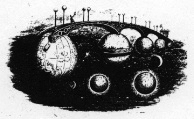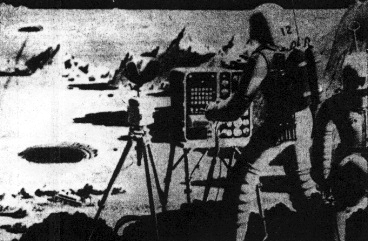|
Science fiction is more than just Buck Rogers By Gregory Renault
1. All facets of everyday life under modern capitalism feature aspects of repression, dominance and reification in constant tension with and opposition to other aspects, the struggle for autonomy and creativity. This dialectic of domination and liberation is readily seen in struggles of national liberation, class conflicts, the politics of the family, and movements for sexual liberation, to cite the more prominent contemporary arenas. Though usually treated as mere ideology or even propoganda, the cultural sphere is another equally important area of our experience filled with the conflict and tension which result from dehumanized life in bureaucratic capitalism. Cultural politics engaged in the service of human liberation begin with the exploration of this dynamic, tracing out the salient forms and functions of cultural contradictions, and relating them to society as a whole. 2. While mass culture theory from Tocqueville on has always been informed by politics, never claiming to be value-free, both radical and conservative forms alike have been marred by a tendency to reduce mass culture to something other than the discrete form of cultural expression that it is. In distinct contrast to bourgeois high culture, divorced from explicit acknowledgment of its social and historical sources by the general social division of labour, mass culture is always seen in relation to the social, and hence the political. Conservative critics attempting to retain the purity of Western civilization react strongly to the defilement of their intellectual preserve. For them, mass culture is simply one facet of the general shift to a mass society heralding the decline of excellence in favor of democratic equality, the individuality for uniformity. Quality of life is equated with the necessary scarcity and limited access to the fruits of civilization endemic in aristocratic orders; culture is preserved only by denying it to the majority, and class hierarchy is defended in the name of Truth. The social change opposed by culture critics like T.S. Eliot, Ortega y Gasset and F.R. Leavis, and viewed ambivalently by liberals like J.S. Mill is initially embraced by radicals. What conservatives view as the extinction of enlightenment by the barbarism of mass society, radicals characterize as the extension of previously limited privileges in the revolutionary moment of the newly ascendant bourgeois class. Extension of political rights and cultural participation are progressive measures accompanying the new forms of class oppression. An ambiguous development however, industrial capitalism's liberatory ideology is used to prevent the actual realization of its own ideals. But in its attempt to translate these bourgeois ideals of freedom, equality and democracy into actual social relations, the socialist tradition also denied the integrity and autonomy of the cultural realm. Enshrined in the Marxist subsumption of political-ideological superstructure under the technical base, cultural activity is seen as a mere reflection of the more important economic relations, and is relegated to sterile propaganda. The conservative and radical views of mass culture simply cannot came to terms with the vitality of popular thought. From the aristocratic perspective, "democratic culture" is a contradiction in terms, for by its very nature culture is only accessible to the few; for the radical, ideology is false consciousness perpetrated by the culture industry, and culture becomes merely a weapon to be utilized in class warfare. As either non-serious entertainment, or as propaganda, the net effect is the same: the denial of the whole symbolic realm of meaning where the purpose and significance of everyday life is continually constituted and (re)defined. 3. Instead, culture is a form of praxis. This remains true even when folk-generated popular culture is replaced by the domination of the market and the commodity form in mass culture. Undoubtedly an aspect of the attempted integration of particularity (as a source of negation) into a bureaucratically administered form of capitalism, mass culture retains the ambiguity of ideology, which speaks the truth even as it attempts to disguise it. Mass culture is a historically specific form of social signification, predicated on the technical, economic and cultural transformations brought about by industrial capitalism. The colonization of the cultural sphere begins in earnest with the transition from competitive to monopoly capital: work relations are rationalized by "scientific management"; concentration and centralization of capital gives rise to the corporation, with application of the detailed devision of labor to management producing specialized marketing agencies; mass consumption is pushed via new media advertising images into previously safe areas of life; family relations and character structures crumble under the onslaught of the market and in response to the increase of direct state intervention into the affairs of everyday life. Yet institutions of social reproduction are not merely agencies
of social control; they are also the site of social The transition from competitive to monopoly capitalism marked by the advent of rationalized mass production, mass consumption and media mass culture retains this cultural dialectic. Appropriation of popular culture's literary formulas into mass culture is paralleled by the erosion of bourgeois high culture, even as subjectivity in general retains an ambiguous ideological tension between affirmation and negation of contemporary life. The Six-Million Dollar Man may affirm literally the mechanical dehumanization we all figuratively feel, and portray as natural and desirable the use of unrestrained power by the state; at the same time it overtly recognizes the reduction of life to an instrumentalized subservience whose only expression is both quantitative and monetary. The reverse is the case for New Wave music, from the start an ambiguous revolt which partook of the very elements against which it struggled, but now co-opted by jaded aesthetes who, in the rush to catch the latest market-managed "counter cultural" fad, rob it of its authenticity by ripping it from the social context within which it derives relevance as a gesture of frustration and resistance. 4. Thus, even as the form of mass culture dialectically combines formulas with originality, its content combines repression with disclosure, identification with estrangement, and affirmation with negation. The examination of one form of mass cultural literature, science fiction, reveals its specific location in this cultural dialectic. Science fiction as an identifiable genre emerged as an essentially ambivalent reaction to the process of developing industrial capitalist society. Its two thematic poles reflect an unease with the new historical changes which were to permeate other mass cultural forms as well: on the one hand, it glorified scientific and technological progress and embraced the new industry and its concomittant social forms; on the other hand, the negative reaction to the alienation accompanying industrial capitalism portrayed the change as regression rather than progress, via romantic critiques based on a longing for earlier, simpler times. Like all mass culture formulas, science fiction combines general archetypes and literary forms (utopias, fabulous voyages, gothic romance) with specific cultural materials rooted in the immediate historical context; from this it derives its particular themes and fictional strategies (alien encounter, questing scientist, distopian satire, evolutionary fable, alternative universe).
Like most modern literature, science fiction is concerned with the alienated human condition, yet it articulates this concern in a distinct manner, as a form of literature concerned with the implications of the problems engendered by industrial society. It particularly utilizes a tradition of themes and devices which create common writer/reader expectations in the context of a strong reception dialectic unique to this form of mass culture (sf fandom). That is, production and consumption are mutually influenced to an extent far greater than in other forms of mass culture, which tend towards a sharply bifurcated active/passive, top-down manipulation of the consumer. But in science fiction, fandom — the network of institutions (newsletters, correspondence, conventions, formal awards procedures) which provide means of reader-writer communication — substantially affects the nature of the production-consumption dynamic. While this tends to enhance the insularity of the sf community, it also makes the literature more responsive to the desires of readers by giving fans (some of whom in turn become writers) an active input into the process of cultural creation; the overall result is that science fiction is fairly responsive to social change. Science fiction also employs a literary approach which powerfully enhances fictional distance to comment indirectly upon society. Unlike the traditional novel, the science fiction setting is ontologically different from our world (regarding space and/or time), yet there remains aesthetic and thematic continuity for interest and intelligibility's sake. The narrative must utilize literary conventions in order for it to make sense to the reader (and in this respect sf is backward, only recently having discovered "modernist" inventions); likewise, regardless how exotic the setting or characters, the issues it deals with must be relevant and interesting to someone living here and now. But while the imaginative worlds of realistic fiction are based on actual contemporary or historical societies, those of science fiction (and modern fantasy as well) are definitely not, being set on other planets, in the future, in alternative universes, and the like. Science fiction is thus particularly able to vicariously reintroduce in its content those "alien" features — the Other, or the Different — so often denied by the one-dimensional mechanisms of exclusion prevalent in our society. The result is to make science fiction essentially social: though fiction, its narrative style, and thematic emphasis are realist in a manner which permits effective, oblique social comment. The retention of some basic rules of the scientific world view as well as the traditional conventions of aesthetic coherence, forces the thematic focus back upon our world. (In fantasy, science is replaced by magic: the specific focus upon contemporary problems then gives way to romantic escapism.) Thus, in the imaginary worlds of science fiction. "fiction" twice removed comes full circle to comment on everyday life under capitalism.
5. Abstractly considered, the form of science fiction reveals a tension between structures of enlightenment and edification: the content of science fiction reveals a dialectic between mimesis and escape, between realism and miagination; while its ambiguous social function features a parallel tension between ideological affirmation and critical negation. Considered historically, the development of science fiction's major phases reveals the dimensions of form, content and social function in their concrete ambivalence. The period of science fiction's emergence in the 19th century is characterized by formal reliance upon mainstream literary techniques and the novel form, while its themes emerge in romantic reactions like Mary Shelly's Frankenstein, the early "scientific romances" of H.G. Wells, as well as the technocratic adventures of Jules Verne. Still a part of the literary establishment, and not yet fully mass culture as we consider it, the emphasis tends towards the critical pole, exploring themes of knowledge as power, the dangers of science, as well as developing critiques of class society (The Time Machine) and imperialism (The War of the Worlds). The second period occurs with the development of mass culture proper, in the cheap, mass produced pulp specialty magazines of the 1920's in the U.S. This period, also featuring the rise of mass advertising and consumption as salient characteristics of newly transformed American life, featured equally drastic changes in form, content and social function of science fiction. It emerged for the first time as a distinct literary entity in the "scientifiction" of Hugo Gernsback's Amazing Stories, formally shifting from novel to short story, thematically shifting to an emphasis on inventions themselves, rather than their social effects — a complete reversal in both areas. Postwar boom and optimism in the new phase of capitalism are reflected in the ideological themes of the period: imperialism, seen in the perpetual conquest of foreign planets; racism, seen in aliens thinly disguised as non-whites: sexism, seen in the male protagonists, with women (when they appear at all) as decorative objects or rewards. Ironically, the birth of science fiction as an independent cultural entity is achieved at the cost of literary excellence as well as critical content. John Campbell's Astounding in the 1940's marked a qualitative shift in form and content again, though not in social function. Growing reader-writer sophistication, and an emerging self-conscious attitude fostered by the fandom phenomenon led to an emphasis away from gadgets as ends in themselves, and towards literary considerations in story construction: a tendency (which continues today) of growing reapproachment between science fiction and mainstream literature. This third phase was further altered by a parallel shift from short story back to novels again, following the explosion of mass market paperbacks in the 1950's. However, though the craftsmanship improved, the themes remained ideological. Overall, they reveal an ahistorical ethnocentrism, with the institutions and values of capitalist America projected throughout the universe as natural and eternal — bourgeois abstraction on a grandiose scale. Science fiction reflected the faith in scientific progress, and the optimism prevalent in the U.S. at its height as a global capitallist power, even as cold war paranoia crept in via fear of aliens, blobs and the like. Since the 1960's science fiction has become "legitimate", entering the academy, as well as the work of mainstream writers such as Burgess, Lessing and Pynchon. It has also become more sophisticated, approaching literary quality from its own side (even while retaining its character as mass culture). What was called the "new wave" marked a culmination of previous developments, an experimentation with literary style and language, but also featuring a critical reversal of science fiction's previous ideological perspective. The most recent return to the critical pole of the continuum is this time a self-conscious one: writers such as LeGuin, Brunner and Delaney incorporate reflections on science fiction into their critiques of social, economic, political, sexual and psychological alienation; more than ever, the unique structures of the science fiction form are being utilized to critically extrapolate and explore new social relations. The most recent shift in science fiction reveals a case of one form of mass culture which has partially transcended its initial thematic and political limitations. 6. Science fiction novels such as LeGuin's The Dispossessed, Delaney's Triton or Russ' The Female Man actively contribute to the ongoing self-criticism of the science fiction community, as well as to the critical consciousness of our society. Current science fiction as a form of mass culture may not be a socially pervasive as television or rock music, but it certainly partakes of the same socio-cultural dynamic. Concrete investigation of science fiction's elements and their socio-historical development, reveals the ongoing dialectic of domination and liberation which characterizes life in modern capitalist society, demonstrating that mass culture shares that drive to humanize our world which is usually characterized in only political terms. Cultural politics is thus an essential part of the struggle for full human liberation.
Published in The Red Menace Volume 3, Number 1, Winter, 1979.
Subject Headings: Fiction - Literature - Novels - Popular Culture - Popular Fiction - Science Fiction |



